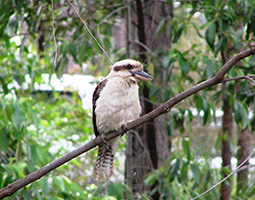Dacelo novaeguineae
Description

The Laughing Kookaburra (Dacelo novaeguineae) is found along the east coast of Australia and has also been introduced to places like Tasmania, south-west Western Australia and even New Zealand. They are a unique bird that is easily identified by its white plumage, brown wings and brown stripe across the eye.
Kookaburras pair for life and will often stick together in family groups that assist in the parenting when the chicks are born. These birds nest in hollowed out branches in trees and have also been known to nest in termite mounds as well.
Although they do not inhabit the central of parts of Australia or the north-west of the country, these ecosystems are inhabited by a larger species of kookaburra, the Blue winged Kookaburra.
Their characteristic 'laughing’ call is a well-known sound in the Australian bush.
Adaptations
- Small prey is eaten whole but larger prey is bashed against a branch to kill and soften it before swallowing
- The 'laughing’ call is often heard at dawn and dusk where it is used to stake the bird's territory
- Sit on perch perfectly still and wait for prey to pass by before attacking
- Lay 3 eggs but last is typically smaller and the chick is killed by siblings if food is scarce
- Strong beak for catching prey
Feeding relationships
- What I eat: insects, worms and crustaceans, although small snakes, mammals, frogs and birds may also be eaten
- What eats me: wedge-tailed eagles, goannas, large snakes, feral cats, large owls, foxes, and grey butcher birds (chicks in particular are vulnerable).
Interesting facts
Kookaburras are also found in New Zealand. They were introduced to our island neighbour in the 1860's and their population has increased to approximately 500 birds in recent years.